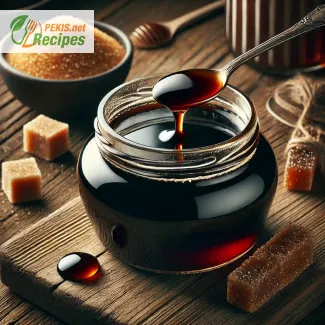
The Comprehensive Guide to Molasses: Health Benefits, Uses, and Nutritional Value
What is Molasses?
Molasses is a thick, dark syrup that is a byproduct of sugar production, derived from either sugar cane or sugar beets. It has been used for centuries as a sweetener, flavor enhancer, and nutritional supplement. Depending on the stage of sugar extraction, molasses can vary in color, texture, and nutritional content.
Characteristics of Molasses
Molasses comes in several different types, which determine its taste, nutritional profile, and uses. The most common varieties include:
Light Molasses
- Extracted during the first boiling of sugarcane or sugar beet juice
- Lightest in color and mildest in flavor
- Contains more sugar than darker molasses
- Commonly used for baking, cooking, and syrups
Dark Molasses
- Obtained from the second boiling of the sugar extraction process
- Thicker and less sweet than light molasses
- Often used for barbecue sauces, gingerbread, and stews
Blackstrap Molasses
- Comes from the third boiling of sugarcane juice
- Contains the highest concentration of vitamins and minerals
- Has a robust, slightly bitter flavor
- Rich in iron, calcium, magnesium, and potassium
Substitutes for Molasses
If molasses is unavailable, several alternatives can provide similar taste and consistency:
- Maple Syrup – Offers a sweeter and less robust flavor
- Honey – Provides a similar viscosity but lacks the deep, complex flavor
- Brown Sugar – A mixture of white sugar and molasses; can be dissolved in water as a replacement
- Date Syrup – Has a thick consistency and natural caramel-like sweetness
- Treacle – A close British equivalent to molasses
Why is Molasses Used in Cooking and Baking?
Molasses adds richness and depth of flavor to a variety of recipes. It enhances the moisture retention in baked goods and provides a unique sweetness that balances savory dishes.
- In Baking – Molasses keeps cookies, cakes, and bread soft and chewy
- In Savory Dishes – Often used in barbecue sauces, baked beans, and marinades
- In Beverages – Added to warm drinks like tea and coffee for natural sweetness
- As a Fermenting Agent – Used in brewing alcoholic beverages such as rum
The Secret Effects of Molasses in Food Preparation
Molasses impacts texture, moisture content, and browning in cooking and baking. The sugars in molasses contribute to the Maillard reaction, which is responsible for browning and caramelization in baked goods. Additionally, the acidity in molasses helps to activate baking soda, leading to improved leavening.
Why is Molasses Ideal for Recipes?
Molasses is highly valued in culinary applications due to its unique properties:
- Adds Depth of Flavor – Rich, robust, and slightly smoky
- Provides Natural Sweetness – Less processed than refined sugars
- Enhances Moisture Content – Ideal for cookies, cakes, and sauces
- Boosts Nutritional Value – Contains minerals that refined sugar lacks
How Does Molasses Work?
Molasses affects food in several key ways:
- Retains Moisture – Prevents baked goods from drying out
- Binds Ingredients – Helps in bread making and fermentation
- Improves Browning – Contributes to the appealing color of grilled meats and baked goods
- Acts as a Preservative – Helps extend the shelf life of homemade syrups and sauces
Health Benefits of Molasses
Molasses is more than just a sweetener; it is a nutritional powerhouse that offers several health benefits:
- Rich in Iron – Helps prevent anemia and supports oxygen transport in the blood
- High in Calcium and Magnesium – Essential for bone health and muscle function
- Source of Potassium – Regulates blood pressure and supports heart health
- Natural Energy Booster – Provides slow-releasing carbohydrates for sustained energy
- Antioxidant Properties – Protects against oxidative stress and reduces inflammation
- Supports Digestive Health – Acts as a natural laxative, aiding in digestion
How is Molasses Produced?
Molasses is made by boiling sugarcane or sugar beet juice. The process involves:
- Crushing and Extracting Juice – Freshly harvested sugarcane is crushed to extract juice.
- Boiling the Juice – The juice is boiled to concentrate the sugars.
- Repeated Evaporation – The syrup is boiled multiple times to remove crystallized sugar.
- Final Extraction – The remaining liquid after the last boiling is blackstrap molasses.
Growing Sugarcane for Molasses Production
Molasses is derived from sugarcane, which requires:
- Warm, tropical climates with abundant rainfall
- Well-drained, loamy soil with rich nutrients
- 6-12 months of growing time before harvesting
- Frequent irrigation and disease control to ensure high yield
Other Uses of Molasses
Beyond culinary applications, molasses has several other uses:
- Animal Feed – A key ingredient in livestock feed
- Fertilizer – Provides nutrients for soil health
- Industrial Applications – Used in the production of ethanol and other chemicals
Why Molasses Deserves a Place in Your Kitchen
Molasses is more than just a sweetener—it is a nutrient-rich, versatile ingredient with wide-ranging applications. Whether you use it for baking, cooking, or health benefits, its deep flavor and mineral content make it an excellent alternative to refined sugar. By incorporating molasses into your diet, you can enjoy better nutrition, enhanced flavors, and a natural energy boost.